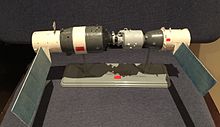Tiangong
Tiangong ( Chinese 天宮 / 天宫 , Pinyin Tiāngōng - "Heavenly Palace") is a space station program of the People's Republic of China . The Tiangong 1 space station was launched in 2011, followed by Tiangong 2 on September 15, 2016. The experience will lead to the construction, launch and operation of a large space station.
preparation
Plans for a Chinese space station had been in progress under the name Project 921 since 1992. A model was shown to the public for the first time at the Expo 2000 in Hanover.
Tiangong 1
Tiangong 1 was launched on September 29, 2011 with a CZ-2F . On November 3, the Shenzhou 8 unmanned spacecraft docked . This was the first docking maneuver in Chinese space travel. On November 14th, Shenzhou 8 disconnected and reconnected before the spacecraft finally left the space station on November 16.
The first crew came on board with Shenzhou 9 on June 18, 2012, putting the first Chinese space station into operation. On June 24th, a decoupling and reconnection was carried out here as well. The three taikonauts left Tiangong 1 on June 27th.
The second crew docked with Shenzhou 10 on June 13, 2013 . The disconnection and reconnection took place on June 23, the final disconnection on June 25.
In March 2016, radio contact with Tiangong 1 was unexpectedly lost. On April 2, 2018 at around 2:15 a.m. CEST , the space station entered the earth's atmosphere. Unless they were burned up by heating in the passing air, their remains fell into the South Pacific.
Tiangong 2

The second Chinese space station Tiangong 2 , which is almost identical in construction , was launched on September 15, 2016. On October 18, 2016, the Shenzhou 11 spacecraft docked with Tiangong 2. Jing Haipeng and Chen Dong formed the station's first and only crew and remained on board until November 17. On July 19, 2019, the station was deliberately brought down.
Big space station
After the smaller Tiangong space laboratories , a large modular space station with a mass of 66 tons is planned. With a docked Tianzhou - Space Shuttle and two Shenzhou -Raumschiffen the total weight will be about 90 tons. The station should consist of three modules and be operated for at least ten years. Three space travelers should be able to live on the station at the same time.
The core module Tianhe ( Heavenly Harmony to 2021 with a) launch vehicle of the type Long March 5B for launch. In the following years, two modules for scientific experiments and other components will follow and be connected to the core module. The space station could be fully operational in 2022 . A space telescope called Xuntian , which is separate from the station and can be serviced from the station, is also planned for 2022 .
In September 2017 it was announced that European astronauts will also be trained to stay at the station, including the German spaceman Matthias Maurer . In May 2018, "All countries, regardless of their size and level of development" were invited to conduct their experiments on the station. A total of 42 projects were submitted, from which the Office for Manned Spaceflight at the Department of Weapons Development of the Central Military Commission , the operator of the space station, and the United Nations Office for Space Affairs selected nine projects for the first working period. The projects announced in Vienna on June 12, 2019 were all collaborations; A total of 23 research institutes from 17 countries, from China and Germany to Kenya and Peru, but not from the USA, got the chance.
- The planned modules
- Tianhe ( 天和 - "Heavenly Harmony") - core module with residential quarters
- Wentian ( 問 天 / 问 天 - "sky survey") - science module
- Mengtian ( 夢 天 / 梦 天 - "Heavenly Dream ") - science module
- Xuntian ( 巡天 - "sky screenable ") - independent of the station space telescope , which is maintained by the station
Individual evidence
- ↑ Entry 天宫 in the Chinese-German online dictionary LEO, accessed on September 16, 2016.
- ↑ Felix Korsch: Project 921-2 - `Chinese Skylab'. raumfahrer.net, August 13, 2003, accessed on February 24, 2016 (English).
- ↑ China Manned Space (CMS): Tiangong-1 reenters the atmosphere. April 2, 2018, accessed April 11, 2018 .
- ↑ n-tv: China's "Shenzhou 11" manages record flight. n-tv.de, November 18, 2016, accessed on April 23, 2017 .
- ↑ a b c Andreas Landwehr : This is how China wants to conquer space. In: Welt.de . April 22, 2016. Retrieved September 30, 2017 .
- ↑ 长征 五号 B 计划 今年 首次 发射. In: spaceflightfans.cn. January 6, 2020, accessed February 3, 2020 (Chinese).
- ↑ 空间站 工程 研制 进展. In: cmse.gov.cn. April 23, 2016, accessed October 11, 2019 (Chinese).
- ↑ a b China to launch space station core module in 2018. In: Spacedaily.com. March 3, 2017, accessed September 30, 2017 .
- ↑ Andrew Jones: Tiangong-2: Video shows docking system for China's new space lab.gbtimes, February 3, 2016, accessed on February 24, 2016 (English).
- ↑ China plans to launch core module of space station around 2018. In: Xinhuanet.com. April 21, 2016, accessed September 30, 2017 .
- ↑ German astronaut is training for a trip to the Sky Palace. In: Bayerischer Rundfunk . September 22, 2017. Retrieved September 30, 2017 .
- ↑ China just invited the world to its space station . In: Ars Technica . ( arstechnica.com [accessed June 2, 2018]).
- ^ 9 Projects in 17 Countries were Selected into the First Batch of Scientific Experiments. In: english.csu.cas.cn. September 16, 2019, accessed October 10, 2019 .
- ^ The United Nations / China Cooperation on the Utilization of the China Space Station. In: unoosa.org. June 12, 2019, accessed October 12, 2019 .

